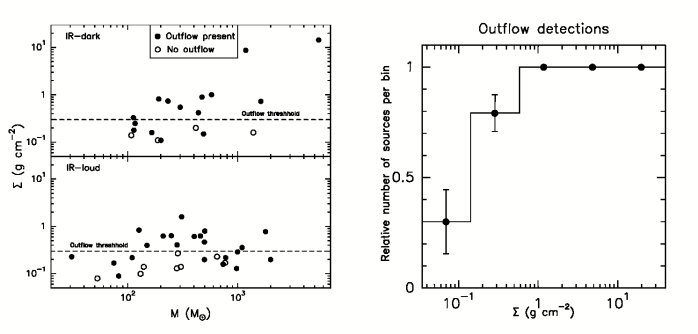| EPoS Contribution |
|
A minimum column density for OB star
formation: An observational test
Ana Lopez-Sepulcre INAF - Osservatorio Astrofisico di Arcetri, Firenze, Italy | |
| Recent theories predict that high-mass star formation may occur only above a minimum surface density of the parental molecular clump. With this in mind, we have searched for OB star formation signposts (mainly infall and outflow signatures) in a sample of 49 massive molecular clumps (M > 100 Msun), including both IR-dark and IR-loud sources and covering a wide range of surface densities. The aim was to look for evolutionary trends and test observationally the above mentioned theoretical prediction. Each of these sources has been mapped in the HCO+(1-0), HCN(1-0), and C18O(2-1) lines with the IRAM-30m telescope in Pico Veleta (Spain). Molecular outflows have been detected in 75% of our targets, and these are equally frequent and massive (between ~1 and ~100 Msun) in IR-dark and IR-loud clumps, implying similar levels of star formation activity in both kinds of objects. In contrast, we find a remarkable change in the outflow detection rate across a threshold corresponding to a surface density of 0.3 g/cm2: above this, the detection rate becomes 100% and the outflows are on average more massive. This conclusion is confirmed by observations of the SiO(2-1) and (3-2) lines (excellent molecular jet tracers) towards the same sample. Our result lends support the theoretical prediction. We also find that the infall detection rate in our sample is low, but significantly higher in the IR-dark sub-sample, an indication that these objects could be associated with the onset of star formation. Chemical differences are found between IR-dark and IR-loud clumps, which include depleted CO and HCN in the former. Therefore HCN may not be a reliable tracer of dense gas for IR-dark clumps. | |
 | |
| Caption: IR-dark (top) and IR-loud (bottom) sub-samples. Plot of surface density against clump mass, M. The dashed line marks the threshold below which the outflow detection rate decreases significantly. Right: Molecular outflow detection rate as a function of surface density for the whole sample. | |
| Collaborators: Cesaroni, INAF - OAdA, Italy C.M. Walmsley, INAF - OAdA, Italy C. Codella, INAF - OAdA, Italy |
Suggested Session: Cores and Collapse, Massive Stars, Molecular Clouds |

